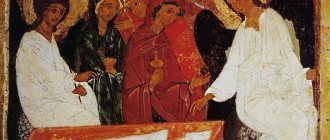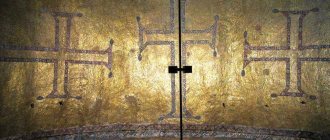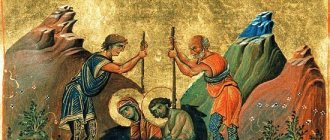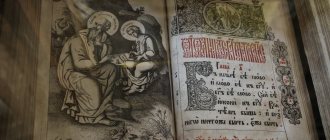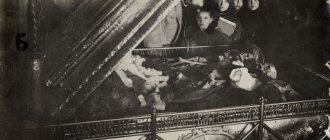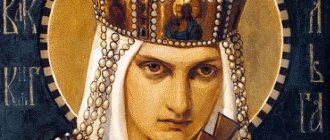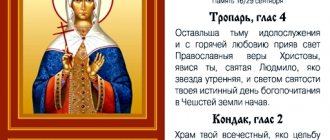"Save me, God!".
Thank you for visiting our website, before you start studying the information, please subscribe to our Orthodox community on Instagram, Lord, Save and Preserve † - https://www.instagram.com/spasi.gospodi/. The community has more than 60,000 subscribers. There are many of us like-minded people and we are growing quickly, we post prayers, sayings of saints, prayer requests, and timely post useful information about holidays and Orthodox events... Subscribe. Guardian Angel to you!
Saint Helena is the mother of Saint Constantine the Great, Equal-to-the-Apostles, a Christian educator, thanks to whom Christianity became the state faith and was freed from all persecution.
- First prayer to the saints
History of the icon
Equal to the Apostles are those saints who performed actions to spread Christianity on the same level as those done by the direct disciples of Jesus Christ - the apostles. Throughout the history of Christianity, there are few women known who have earned the title of Equal-to-the-Apostles, and Saint Helena is one of them.
What do we know about her life?
Elena was born in III in the city of Drepana, in a simple family, now it is a small town of Hersek, located in Turkey. Her father was the caretaker of the horse station.
In 270, she met the ruler of the Western part of the Roman Empire, Constantius Chlorus, and after some time married him. It was from him that the woman gave birth to Constantine the Great, who became the first Christian emperor.
Elena's husband quickly climbed the career ladder. One day he was offered the important post of ruler of the Roman lands, but there was one condition: for this he needed to leave his wife and get engaged to the emperor’s daughter. Constantius agreed and eventually became the ruler of the Western Territories of the Roman Empire.
This title was inherited by his son Konstantin, who was also a warrior. Over time, Constantine enters into an alliance with the ruler of the Eastern lands, Maximilian, and becomes the ruler of the entire empire. It was by his decree that Christianity was legalized.
The best article for you, go to: St. Nikita the recluse of Pechersk, Bishop of Novgorod
When Constantine became emperor, he elevated his mother to the dignity of Augusta (queen), thus making her, in fact, his co-ruler.
Saint Helena converted to faith at the age of 60 under the influence of her son, and made her pilgrimage to the Holy Land, Jerusalem, at the age of 80, after she had a vision in a dream in which she was commanded to find the greatest Christian shrines on Calvary.
After complete excavations, the Cross of the Lord, nails and a tablet with the inscription: “Jesus of Nazareth, King of the Jews” were found. In addition, the burial cave of Jesus Christ was discovered.
What does the icon look like?
In the icon, Elena is depicted together with her son Constantine. The saints hold the Cross of the Lord in their hands, thus the icon painter talks about the contribution of mother and son to the development and spread of Christianity.
The Life of Saints Equal-to-the-Apostles Helen and Constantine (from the book of the nun Nektaria (Mc Lees)
Tradition has preserved for us information that the holy Empress Helen was not of noble birth.
Her father was the owner of a hotel. She married the famous Roman warrior Constantius Chlorus. It was a marriage not out of political calculation, but out of love, and in 274 the Lord blessed their union with the birth of their son Constantine. They lived happily together for eighteen years, until Constantius was appointed to rule Gaul, Britain and Spain. In connection with this appointment, Emperor Diocletian demanded that Constantius divorce Helen and, after the divorce, marry the new ruler to his stepdaughter Theodora. The emperor also ordered the eighteen-year-old son of Constantius and Helen, Constantine, to be taken to his capital in Nicomedia under the pretext of teaching him the art of war. Thus, as an eighteen-year-old boy, Constantine became virtually a hostage to his father’s loyalty to the emperor. At the time when these events occurred, Elena was just over forty years old. She moved closer to her son, to the town of Drepanum, not far from Nicomedia, where her son could visit her. Drepanum was subsequently renamed Elenopolis in her honor. It was here that Elena learned about the Lord Jesus Christ and was baptized. For the next thirty years she was engaged in the purification and improvement of her own soul, which served as preparation for the fulfillment of a special mission, the work for which she was called “equal to the apostles.”
Soon Constantine, who often visited his mother, met a Christian girl named Minervina in her house. After some time, the young people got married. Two years later, the young wife died of a fever, and Constantine gave their little son, named Crispus, to the care of his mother. Fourteen years have passed. Constantine's father, a military leader dearly loved by his soldiers, died. Constantine, who showed considerable military valor, achieved the rank of tribune, and, thanks to universal respect in the army, he was elected as his father's successor. In 306 he became Caesar of the western lands. Under the vivid impression of seeing the terrible persecution of Christians in the East, Constantine, having inherited power from his father, considered his first task to confirm all his father’s orders in favor of Christians and declared freedom to profess Christianity in his regions. Already in 315, Constantine issued the Edict of Milan, according to which Christianity received legal status. This Edict put an end to the Roman persecution of Christians, which had lasted several centuries.
Emperor Maximian regarded Constantine as his rival for power and therefore decided to “neutralize him” by marrying his daughter Fausta. However, it was an unhappy union, and in the next few decades Constantine had to devote more energy and time to fighting his wife's relatives than to the enemies of Rome. A miraculous sign was given to Constantine in 312, on the eve of the battle against his brother-in-law Maxentius. Constantine stood with his army at the walls of the capital. A fiery cross was shown to him in the night sky, and Constantine heard the words spoken by the Savior Himself, who commanded him to go into battle with banners with the image of the Holy Cross and the inscription “By this victory.”
Maxentius was indeed defeated in the battle with Constantine.
And after another ten years, Constantine became the sole Emperor of the eastern and western parts of the Empire. Therefore, in 323, he was able to elevate his mother, declaring her Empress.
For Elena, who by that time had managed to understand how transitory the joys and bitterness of earthly glory were, imperial power itself was of little attraction. However, she realized that her new position gave her the opportunity to participate in the spread of the Christian gospel, especially by building churches and chapels in the Holy Land, in those places where the Lord lived and taught.
Since the destruction of Jerusalem by the Romans in 70 AD, this land no longer belonged to the Jewish people. The temple was razed to the ground, and the Roman city of Aelia was built on the ruins of Jerusalem. The Temple of Venus was erected over Golgotha and the Holy Sepulcher. Elena's heart burned with the desire to cleanse the holy places from pagan defilement and rededicate them to the Lord. She was already more than seventy years old when she set off on a ship from the coast of Asia Minor to Palestine.
Arriving in the Holy Land, she ordered the temple of Venus to be demolished and its rubble taken outside the city walls. The queen did not know where to dig to find the Cross in the huge piles of earth, stones and debris. She fervently prayed for admonition, and the Lord came to her aid.
Finding the Holy Cross of the Lord
This is how it is described in her Life:
The discovery of the Holy Cross of the Lord took place in the year 326 from the Nativity of Christ as follows: when the rubble remaining from the buildings that stood here was cleared away at Golgotha, Bishop Macarius performed a prayer service at this place. The people digging the ground felt a fragrance emanating from the ground. This is how the Cave of the Holy Sepulcher was found. The true Cross of the Lord was found with the help of a Jew named Judas, who retained in his memory the ancient legend about its location. He himself, after finding the great shrine, was baptized with the name Kyriakos and subsequently became the Patriarch of Jerusalem. He suffered a martyr's death under Julian the Apostate; The church celebrates his memory on October 28.
Following the instructions of Judas, Elena found, east of the Cave of the Holy Sepulcher, three crosses with inscriptions and nails lying separately. But how was it possible to know which of these three crosses was the True Cross of the Lord? Bishop Macarius stopped the funeral procession passing by and ordered to touch the deceased one by one with all three crosses. When the Cross of Christ was placed on the body, this man was resurrected. The Empress was the first to bow to the ground before the shrine and venerate it. People crowded around, people tried to squeeze forward to see the Cross. Then Macarius, trying to satisfy their desire, raised the Cross high, and everyone exclaimed: “Lord, have mercy.” So on September 14, 326, the first “Exaltation of the Cross of the Lord” took place, and to this day this holiday is one of the Twelve (greatest) Holidays of the Orthodox Church.
Helena took a piece of the Cross to Byzantium as a gift to her son. However, most of it, encased in silver, remained in the temple she built at the site of its discovery. Every year on Good Friday it was taken out for worship. A small part of the Holy Cross is still in Jerusalem. Over the centuries, small particles of it were sent to temples and monasteries throughout the Christian world, where they are carefully and reverently kept as priceless treasures.
Saint Helena lived in Jerusalem for two years, leading the restoration of the holy places. She developed plans for the construction of magnificent churches in places associated with the life of the Savior. However, the modern Church of the Holy Sepulcher is not the same church that was built under St. Helena.2 This large building was built in the Middle Ages, and there are many small churches inside it. Including the Holy Sepulcher and Golgotha. Under the floor, on the back side of Calvary Hill, there is a church in honor of St. Helena with a stone slab at the site of the discovery of the Cross.
The Church of the Nativity in Bethlehem is the same one that was erected by the Empress. There are other churches in the creation of which she was directly involved, for example, the small Church of the Ascension of the Lord on the Mount of Olives (now owned by Muslims), the Church of the Assumption of the Virgin Mary near Gethsemane, the church in memory of the appearance of three angels to Abraham at the Oak of Mamre, the temple on Mount Sinai and the monastery of Stavrovouni near the city of Larnaca in Cyprus.
In addition to the fact that Saint Helen invested enormous energy and strength in the revival of the holy places of Palestine, she, as the Life tells, remembering her own years of life in humiliation and oblivion by the rich and powerful of this world, regularly organized large dinners for the poor of Jerusalem and its surroundings. At the same time, she herself put on a simple work dress and helped serve the dishes.
When she finally returned home, bitter, sorrowful news awaited her there. Her beloved grandson Crispus, who had become a valiant warrior and had already proven himself in the military field, died, and, as some believed, not without the participation of his stepmother Fausta, who did not want this young military leader, popular among the people, to be an obstacle on the way to the Imperial throne her own three sons.
Her work in the Holy Land tired her, and grief fell like a heavy burden on her shoulders. After the news of the death of Crispus, she lived only a year and died in 327. Emperor Constantine outlived his mother by ten years.
The Church celebrates the memory of the holy Equal-to-the-Apostles Tsar Constantine and his mother Queen Helena on May 21, old style.
Since Constantinople had not yet been founded by this time, the remains of Queen Helena were transferred to Rome and buried in the imperial tomb built by Constantine on the Labican road at the Basilica of Saints Marcellino and Peter (Santi Marcellino e Pietro).
And a few years later, the remains of Queen Helena, or part of them, were transferred to the new capital of Constantinople and placed in the imperial tomb of the Temple of the Twelve Apostles. What followed was a long history of the distribution of parts of the relics of Saint Queen Helena throughout various countries of both Western and Eastern Europe.
Thus, according to information preserved in Catholic tradition, in the 12th century, by order of Pope Innocent II, part of the relics of Queen Helena was transferred to the Roman Basilica of the Blessed Virgin Mary “on the altar” (Santa Maria in Aracoeli). This church was built in the 6th century on the top of the Capitoline Hill, where, according to legend, the Tiburian Sibyl Albunea predicted the coming of the Messiah to Emperor Augustus.
The relics of the queen were placed in a porphyry tomb in the chapel of St. Helena, to the left of the main altar of the church, where they are exhibited for veneration in our time.
Another part of the relics of St. Helena was stolen in the 9th century by the monk Tejis, who received miraculous healing from them, and was placed by him in the French monastery of St. Peter in Auvilliers near Reims. The holy remains were kept there until the beginning of the 19th century, and during this time they became famous throughout Europe for the numerous miracles that came from them, turning Ovilliers into one of the famous pilgrimage centers. During the French Revolution and the beginning of the persecution of the Church, one of the monks of the monastery of Auvilliers, knowing that a detachment had been sent to it, having received orders to destroy the monastery and confiscate the monastery property, moved the shrine to the church located in the neighboring village.
And in the 19th century, the relics of Queen Helena were transferred to the Knights of the Holy Sepulcher, who placed them in the Parisian church of Saint-Leu-Saint-Gilles. This is an ancient French temple of the 12th century, dedicated to the holy martyrs Bishop Leu and the hermit Gilles, in which the Knights of the Holy Sepulcher held annual meetings. The relics of Queen Helena were placed in a reliquary under the altar, along with all the documents that had accompanied them for seven centuries, confirming their transfer back in the 9th century from Rome. They are kept there to this day, and their presence in this Parisian church was discovered quite recently - at the very end of the 20th century. For a long time, the shrine with holy relics was located high above the main altar of the temple; but after she was discovered and pilgrims flocked to her, a special crypt was built underneath to store the relics of the holy queen. On September 28, 1997 - the day after the Feast of the Exaltation of the Cross - the first Orthodox prayer service in the last nine centuries was held in the church of Saint-Leu-Saint-Gilles in front of the relics of Saint Helena.
Description of the holy image
Lifetime images of the queen’s image, her sculpture and coins with a profile have survived to this day. Of course, in these images the queen’s facial features are slightly distorted, but they still correspond to reality.
They began to venerate the Saint immediately after her death, and several centuries later the first icon with her face was painted. Over time, a special tradition developed regarding exactly how to depict Elena on icons. Very rarely a woman is depicted alone on icons; as a rule, she is always together with her son, who stands on her left hand, and there is a cross between them.
There are also images with hagiographical stamps and small miniatures showing scenes of the main events in the life of the saint: the vision, the journey to the Holy Land and the finding of the Cross of the Lord.
On all icons the woman is depicted as young, although she came to faith as an 80-year-old woman, thus the icon painters emphasized her spiritual youth.
The best article for you, go to: What does the Icon of the Martyr Matrona of Thessalonica help with?
Modern icon painters most often depict the holy queen unaccompanied by her royal son, but invariably holding a cross in her right hand.
Merits of Saint Helena
Constantine always wanted to find the Cross on which Christ was crucified. To do this, he sent his mother, Queen Helena, to the Holy Land. She was accompanied by clergy, including the Patriarch himself. The search for the Cross was like a legend. Three crosses were found on Calvary, but which one is Christ's? In order to determine this, they decided to place all three crosses in turn on the deceased who was being carried to burial at that time.
The procession stopped, after placing one of the crosses on the deceased, the dead man was resurrected! Then the Patriarch began to raise high the Life-giving Cross of Christ, and all the people shouted: “Lord have mercy!” holiday of the Exaltation of the Life-Giving Cross of the Lord was established (celebrated on September 27).
For this merit, the Church ranked Queen Helen among the rank of saints equal to the apostles. Having handed the shrine to the Patriarch, the saint took part of the Cross in order to bring it as a gift to her son, Constantine. After arranging a rich meal for the poor, Elena returned home, where she soon gave up her soul to God.
The meaning of the icon of Saints Constantine and Helen
The icon has a huge visual impact on a person and is of great importance for all Christians:
- · an iconographic image where the Saint, together with her son, symbolizes the inviolability of family values and filial love for the mother;
- · the cross in the hands of a woman symbolizes devotion to the true faith and readiness to suffer for Christ.
In the Christian world, Helen was revered at all times and enjoyed great respect.
It was the name Elena that Princess Olga took during her baptism.
How does the icon of Constantine and Helen help?
You need to pray in front of the images of the Saints asking for help, because they are close to God and will be able to help with your requests.
In addition, God gave every saint the opportunity to help people in one or another matter or request. When praying before the icon of Queen Helen, Equal to the Apostles, people should know that she also has areas where she can quickly help a person, provided that he sincerely believes.
Basically they pray before the face:
- about healing from diseases and illnesses;
- when starting a difficult but necessary task;
- before the construction of temples;
- participants in elections for responsible positions.
The saint also helps people who occupy high government positions.
St. Helen's main focus is on helping and praying for those in power who are asking for financial assistance.
Do not forget that the Saints help all those who ask for help, regardless of their position and type of employment.
Finding the Life-Giving Cross of the Lord
How many amazing stories the history of the Orthodox Church contains. It was the fourth century after the birth of Christ. Equal to the Apostles Tsar Constantine the Great learned from Christian bishops that somewhere in Jerusalem the Holy Cross on which our Lord Jesus Christ was crucified was kept. The king asked his mother, Queen Helena, to go to the holy city and find the cross of the Lord. Arriving in Jerusalem, Queen Helena asked the residents who might know the exact place where the Life-Giving Cross was hidden. “We don’t know it,” the Christians answered her. The Jews keep this secret, passing it on from generation to generation. Elena gathered the leaders of the Jewish community and asked them one single question: “Where are you hiding the cross on which the Lord Christ was crucified?” They tried to deny, “We don’t know, they say, and how can we know.” But fearing the queen’s anger, they pointed to their old relative named Judas. “He knows exactly where this place is,” they assured Saint Helena.
A few hours later, that same Judas was brought in for questioning by the queen. “Tell me, where is the Cross of the Lord Jesus Christ, whom you call a Nazarene, kept?” - “Oh, Lady, if only someone knew this, it is a mystery that will never be solved.” - “Are you telling me the truth, or are you lying?” - “The absolute truth!” There was concern in the old man's eyes. It was obvious that he was being cunning and this did not escape Queen Helena. “Do you know that I can execute you for lying, or I can have mercy. But even after these words, Judas remained silent, and then the queen pronounced her sentence: “Judas, for trying to deceive me, I order you to be thrown into a deep ditch until you tell us the exact burial place of the Cross of the Lord.” The queen's order was immediately carried out.
After sitting in the ditch for some time, Judas made a promise to act according to the will of the queen. He pointed out where the Holy Cross was buried and was released. Judas walked home dejectedly, complaining that he had discovered a secret that he had promised his ancestors to firmly keep. And suddenly he was overcome by an irresistible desire to see how Christians would dig up the Cross. He returned back to Golgotha, where the pagan temple stood. The warriors quickly destroyed it and began to dig into the ground. Suddenly the whole air was filled with a wonderful fragrance and three crosses were pulled out of the ground. Judas looked at this without taking his eyes off. But which of the three crosses is the Lord’s? “You will never know this again,” thought Judas.
But just at that time a funeral procession passed by. By order of Queen Helena, they stopped her and began to place the dug up crosses one after another on the deceased. “What do they want? Why are they doing this? – Judas was perplexed. But then I suddenly saw that after laying the third cross, the deceased moved and stood up. Judas' legs gave way. “No, this is not an obsession, this is a real miracle! I didn’t believe it, but a miracle happened before my eyes!” It is difficult to convey what was happening in his soul at those moments and how he spent the rest of the day and night. But the very next morning he came to the Christian bishop and asked for baptism.
The bishop was quite surprised, but fulfilled the request. And Judas became a Christian - Cyriacus. The name Kyriak means “Lordly” in Greek. It was not given to him by chance, because a few years later, Kyriakos was elevated to the rank of bishop and even became the patriarch of Jerusalem. Day and night he wrote letters of exhortation to his fellow Jews, as well as to the pagans, retelling to them the story of his conversion to Christ and urging them to accept the Christian faith.
When Julian the Apostate reigned on the throne of Constantinople, he forced Saint Cyriacus to sacrifice to idols. Unable to break him, the emperor ordered the patriarch to cut off precisely the hand with which Cyriacus wrote his messages. The bishop said in response to this: “I will offer not only my hand, but also my whole self as a holy sacrifice to Christ, because I have come to know that he is truly the Mission for whom our ancestors were waiting.” The holy patriarch accepted death for Christ at the hands of the wicked apostate emperor. And he entered the bright heavenly kingdom, where to this day he reigns with all the righteous.
Prayer to Saints Constantine and Helena
First prayer to the saints
About Saints Equal-to-the-Apostles Constantine and Helen! Deliver this parish and our temple from every slander of the enemy and do not abandon us, the weak (names), through your intercession, beg the goodness of Christ our God to grant us peace of mind, from destructive passions and all filth, abstinence, and unfeigned piety. Ask us, pleasers of God, from above for the spirit of meekness and humility, the spirit of patience and repentance, so that we may live the rest of our life in faith and contrition of heart, and so at the hour of our death we will gratefully praise the Lord who glorified you, the Father Without Beginning, His Only Begotten Son and the Consubstantial All-Blessed One. Spirit, the Indivisible Trinity, forever and ever.
Second prayer to Saints Constantine and Helena
About the wonderful and all-praised king, the holy Equal-to-the-Apostles Constantine and Helen! To you, as a warm intercessor, we offer our unworthy prayers, for you have great boldness towards the Lord. Ask Him for the peace of the Church and prosperity for the whole world, wisdom for the ruler, care for the flock for the shepherd, humility for the flock, the desired peace of the elder, strength for the husband,
splendor for wives, purity for virgins, obedience for children, Christian education for babies, healing for the sick, reconciliation for those at war, patience for the offended, fear of God for the offended. To those who come to this temple and pray in it, a holy blessing and everything useful for each request, let us praise and sing the Benefactor of all God in the Trinity of the glorified Father, and the Son, and the Holy Spirit, now and ever and unto ages of ages. Amen.
The best article for you, go to: St. Paul of Thebes
LiveInternetLiveInternet
Since Constantine the Great, Equal-to-the-Apostles , was the son of Constantius Chlorus, who ruled the western part of the Roman Empire (Galilee and Britain), and Saint Helen, Equal-to-the-Apostles. He was encouraged to accept Christianity by his Christian mother. His father, although he was a pagan, patronized Christians, seeing that they were faithful servants and honest citizens. Throughout the rest of the Roman Empire, Christians were subjected to severe persecution by the emperors Diocletian, his co-ruler Maximian Galerius in the East, and the emperor Maximian Herculus in the West.
At the request of Emperor Diocletian, in his youth (18 years old), Constantine was taken from his parents as a hostage and lived at court in Nicomedia. Court life in the capital then personified in a small form all the moral and religious corruption to which humanity can reach, enslaved by unclean, passionate lusts - vain pomp and luxury, drunkenness and gluttony, unbridled depravity of thought and life, intrigue and sedition, bitterness against true worship of God and hypocritical, false respect for imaginary gods. On the other hand, Constantine saw a completely different life of the Christian community, where elders and elders, young men and maidens, simpletons and learned sages, even children proved the truth of their faith, the purity and height of its content not only with words, but also with their deeds, by suffering for it even to death. Subsequently, Constantine himself admitted that his stay at the court of Diocletian greatly contributed to his conversion to Christianity: “I was alienated from the hitherto rulers, he said, because I saw the savagery of their morals.”
After the death of Constantius Chlorus, his son Constantius in 306 was proclaimed emperor of Gaul and Britain by the troops. The first task of the new emperor was to proclaim freedom of professing the Christian faith in the countries under his control. The pagan fanatic Maximian Galerius in the East and the cruel tyrant Maxentius in the West hated Emperor Constantine and plotted to overthrow and kill him, but Constantine warned them and in a series of wars and with the help of God, defeated all his opponents.
to God to give him a sign that would inspire his army to fight bravely. In the year 312, during the war with Caesar Maxentius, shortly before the decisive battle, Constantine with his own eyes saw a luminous cross in the sky with the inscription: “By this way conquer” (in Greek: NIKA). This sight horrified both the king himself and the army that was with him, for the cross, as a shameful instrument of execution, was considered a bad omen by the pagans. Konstantin was perplexed. At night, in a dream, the Lord appeared to him with the same sign of the cross and said that with this sign he would defeat the enemy. Rising from sleep, Constantine called experienced craftsmen and ordered to build, in the likeness of the image of the cross, a banner of gold and precious stones; He ordered his soldiers to depict the Cross on their shields and helmets.
Constantine cross
The combination of (combined) letters known as the monogram of Constantine is made up of the first two letters of the word Christos - “Chi” and “Rho”.
by the wondrous vision, Constantine decided not to worship any other gods except Christ who appeared to him. From that time on, he began to diligently read the Holy Scriptures and constantly had priests with him, although he had not yet received holy baptism.
Having become the sovereign ruler of the Western part of the Roman Empire, Constantine issued the Edict of Milan on religious tolerance in 313, and in 323, when he reigned as the sole emperor over the entire Roman Empire, he extended the Edict of Milan to the entire eastern part of the empire. After three hundred years of persecution, Christians for the first time had the opportunity to openly confess their faith in Christ.
Constantine stopped pagan games; exempted the clergy from civil duties and church lands from general taxes; abolished execution by crucifixion; allowed the freeing of slaves in churches without special formalities (very difficult in civil courts); prohibited private individuals from making sacrifices to idols and using fortune telling in their own homes; ordered the whole empire to celebrate Sunday; to protect Christian virgins, he abolished the Roman laws against celibacy; granted the Church the right to receive property under wills; allowed Christians to occupy the highest government positions; ordered the construction of Christian churches and forbade the introduction into them, according to the custom of pagan temples, of imperial statues and images.
Most of all, Constantine encountered opposition in Rome, where paganism was strong. He decided to found a new Christian capital on the banks of the Bosphorus and invited Christian bishops to solemnly consecrate it, calling it Constantinople . Extensive palaces, aqueducts, baths, and theaters decorated the capital; it was filled with art treasures brought from Greece, Italy and Asia. But temples dedicated to pagan gods were no longer built there, and instead of the Colosseum, where gladiator fights took place, a circus was set up for horse competitions. The main decoration of the new city were temples dedicated to the true God.
Constantinople during the heyday of the Byzantine Empire
Constantine was deeply convinced that only the Christian religion could unite the huge, heterogeneous Roman Empire. He supported the Church in every possible way, brought back Christian confessors from exile, built churches, and took care of the clergy.
Deeply revering the Cross of the Lord, the emperor wanted to find the very Life-giving Cross on which our Lord Jesus Christ was crucified. For this purpose, he sent his mother, the holy queen Helen, to Jerusalem, giving her great powers and material resources. There Saint Helena did not dress in the attire characteristic of her rank, walked in the most modest clothes among the crowd of people and, trying to be unrecognized, gave out generous alms.
In Palestine, all the places consecrated by the gospel events have long been devastated. The Cave of the Holy Sepulcher was filled with rubbish, and on a hill built on top of the holy cave, a temple was built for the “voluptuous demon of love” - Venus. According to Elena’s instructions, idolatry temples erected on places sacred to Christians were destroyed and holy temples were built in their place. At the expense of the queen, churches were built in Bethlehem, above the cave of the Nativity of Christ; on the Mount of Olives - the place of the Ascension of the Lord; in Gethsemane - the place of the Dormition of the Blessed Virgin Mary; at the oak of Mamre - at the place of the appearance of the Holy Trinity to Abraham.
After a long and intense search for the Cross of the Lord, its location was finally indicated by a certain Judas, a Jew, an old man of advanced years, the son of a Jewish teacher - under a pagan temple built on a hill covering the cave of the Holy Sepulcher.
[/td]
| Cave of the Holy Sepulcher | Place where the Holy Cross was found |
The vault of the Holy Sepulcher was found and cleansed; Near it, on the eastern side, three crosses were found, and next to them a board with an inscription and honest nails. But how was it possible to find out which of the three crosses was the Cross of the Savior? It happened that at that time a dead man was being carried past this place for burial; Saint Macarius ordered the funeral procession to stop; They began to believe, on the advice of the bishop, that the crosses found were one for the deceased, and when the Cross of Christ was laid, the dead was resurrected.
Seeing this miracle, they rejoiced and glorified the power of the life-giving Cross of the Lord. And so that it would be possible to see the shrine at least from afar, Saint Macarius reverently raised it and stood on an elevated place, erecting the Cross of the Lord in front of the eyes of many faithful, who at that time loudly exclaimed: “Lord, have mercy!” This was the first Exaltation of the Honest and Life-Giving Cross ; it happened in 326 . The Orthodox Church celebrates this event annually on September 14th.
The Holy Cross, which was then placed in a silver ark for preservation, then converted many of the pagans and Jews to Christ; including Judas, who indicated the place of its storage. Saint Helena, leaving Jerusalem, took a piece of the life-giving Tree with her as a gift to her son Constantine.
Elena died at the age of 80 - according to various assumptions, around 327-330. The place of her death is not known exactly, it is called Trier, where she had a palace. For her great services to the Church and her labors in obtaining the Life-Giving Cross, Queen Helena is called Equal to the Apostles .
Above the cave of the Holy Sepulcher, Emperor Constantine himself ordered the construction of a magnificent temple in honor of the Resurrection of Christ, which would be “more magnificent than all the temples existing anywhere.”
The peaceful existence of the Christian Church was disrupted by the unrest and discord that arose within the Church due to the emergence of heresies. Even at the beginning of the activity of Emperor Constantine, the heresy of the Donatists and Novatians arose in the West, demanding the repetition of baptism over Christians who had fallen away during persecution. This heresy, rejected by two local councils, was finally condemned by the Council of Milan in 316. But especially destructive for the Church was the heresy of Arius, which arose in the East, which dared to reject the Divine essence of the Son of God and teach about the creatureliness of Jesus Christ. By order of the emperor, the First Ecumenical Council was convened in 325 in the city of Nicaea . 318 bishops gathered for this Council, its participants were bishops-confessors during the period of persecution and many other luminaries of the Church, among whom was St. Nicholas of Myra. The Emperor attended the meetings of the Council. Having irrevocably condemned Arianism, the Fathers of the Council decided to give believers an exact confession of Orthodox teaching - the Creed. Constantine proposed introducing into the Symbol the term he had heard in the debates of the Council, “Consubstantial with the Father.” The word spoken by the king was unanimously accepted by the Council and served as the definitive basis for the teaching about the Face of the Lord Jesus, the central Christian dogma.
Constantine lived after that for more than 10 years, adhering with unwavering fidelity to the Nicene Confession of Faith, and zealously tried to establish the spirit of Christian piety in his kingdom, setting a worthy example in himself. Long before his death, Konstantin began to prepare for it. In his new capital, he built a temple in the name of the holy Apostles, in which he built his tomb.
In 337, Constantine solemnly celebrated Easter in Constantinople for the last time and soon fell ill. But he had not yet been baptized. The pious king postponed his baptism out of humble awareness of his sinfulness, wanting to prepare himself for this through the feat of his whole life. Moreover, in his soul there was a sincere desire to be baptized in the waters of the Jordan River. Feeling an extreme decline in bodily strength, Constantine summoned the bishops and asked them to honor him with holy baptism, saying: “I thought of doing this in the waters of the Jordan River, where, in our image, the Savior Himself was baptized; but God, who knows the Useful, honors me with this here.” Dressed in white clothes at baptism, he did not take them off until his death. The scarlet - this royal distinction - the “servant of God” no longer wanted to touch.
The Great and Equal-to-the-Apostles Constantine died, bequeathing the kingdom to his three sons, on the day of Pentecost in 337, in the thirty-second year of his reign.
Troparion, tone 8
Having seen the image of Your Cross in heaven, and just as Paul did not receive the title from man, Your Apostle became king, O Lord, place the reigning city in Your hand: save it always in the world through the prayers of the Mother of God, who alone is the Lover of Mankind.
Kontakion, tone 3
Constantine today, with the matter Helena, the cross reveals the all-honorable tree, for the shame of all the Jews exists, and a weapon against the faithful kings: for for our sake a great sign has appeared and a terrible sign in battle.
Source:
Text:
https://hram-troicy.prihod.ru/zhitie_svjatykh_razdel/view/id/1126934
Image:
Icon: Holy Equal-to-the-Apostles King Constantine and Equal-to-the-Apostles Queen Helena,
https://days.pravoslavie.ru
Icon: The Exaltation of the Cross of the Lord, workshop of Catherine Ilyinskaya;
Illustration by Natalia Klimova;
Icon: Holy Prince Constantine, dmitrovicona.ru;
Internet.
Series of messages “Equal to the Apostles Helen of Constantinople”:
Part 1 - Equal to the Apostles Tsar Constantine and his mother Queen Helen Part 2 - Holy Equal to the Apostles Helen of Constantinople. Exaltation of the Holy Cross. Video Part 3 - Exaltation of the Honest and Life-Giving Cross of the Lord

